Campanula Flowers: Varieties, and Caring For Campanula Bellflower Plants
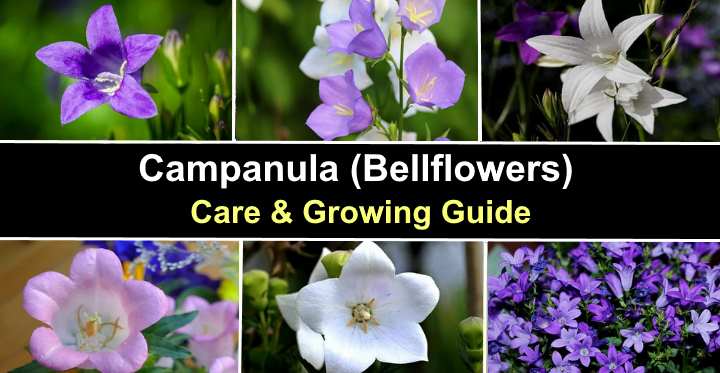
Campanula (bellflower) is a group of flowering plants with dainty bell-shaped or star-shaped flowers. Campanula flowers have five-lobed petals that grow 0.8” to 1” (2 – 2.5 cm) long. The beautiful bellflowers can be in shades of purple, blue, pink, or white. Whether growing as annuals, evergreen perennials, or herbaceous plants, you can find campanula flowers blooming from late spring throughout the summer.
Growing campanula flowers is relatively easy in a sunny garden. The eye-catching campanula flowers can be perennials, annuals or biennials, depending on the variety, and they thrive in well-drained soil. You can also grow the delightful blue, purple, white, or pink campanula flowers in containers to add color to a patio, container garden, or entranceway. The creeping campanula flowering stems are also suitable for growing in hanging baskets or cascading over walls for a colorful waterfall effect.
This article is a comprehensive guide to some of the most attractive campanula flowers for your garden landscape. Additionally, you will find some handy tips on growing bellflowers, so their bell- and star-shaped blooms thrive through spring and late summer.
About Campanula Flowers
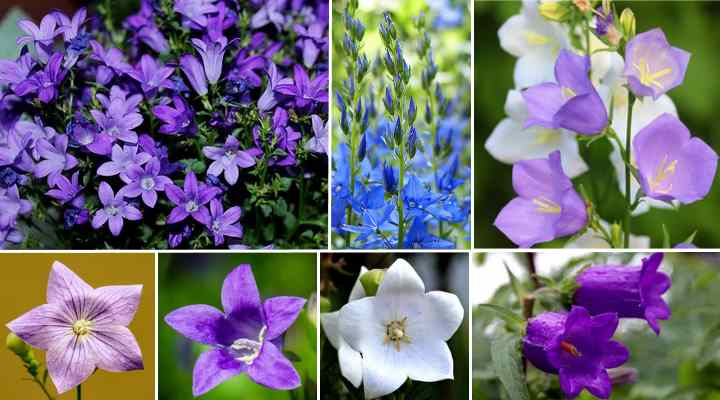
Campanulas (bellflowers) include many varieties in shades of purple, pink, blue and white
Campanula flowers also go by the name bellflowers due to their bell-like flowers that grow in clusters at the ends of or along slender stems. Although many varieties of campanula flowers are low-growing, some species can grow up to 6 ft. (1.8 m) tall. The dwarf and alpine bellflower varieties can be as short as 2” (5 cm) tall.
Over 500 species of campanula plants are native to subtropical and temperate regions in Europe, Asia, and North America. You will often find campanula flowers growing in shady areas of moist meadows, open woods, and near riverbanks.
Campanula flowers are hardy plants suitable for growing in USDA zones 4 through 8. However, some of the hardiest bellflowers survive freezing temperatures in zone 3.
The attractive feature of campanula plants is their bell shaped flowers. Although purple and blue flowers are the most common, some varieties of bellflowers have white or pink flowers. Bellflowers have long-lasting blooms. However, you can also extend the bloom time by deadheading spent flowers.
The bell-shaped flowers typically droop over, nodding in gentle breezes. Some flowers have an open end, giving the flower a star-shaped, cup appearance. Other types of bellflowers look more like small purple urns dangling in clusters.
Campanula or bellflowers have many uses in a garden landscape. The clump-forming flowers grow as ground cover in full sun to partial shade, border plants, edging plants, or grow as cut flowers.
For example, cup and saucer campanula flowers are ideal for cottage gardens. Purple star-shaped bellflowers are ideal for dappled shade as an understory plant. However, tall white bellflowers are a perfect choice for growing in mixed flower beds or containers.
Varieties of Campanula Flowers (Bellflower) – with Pictures and Identification
Here are some of the eye-catching varieties of campanula plants that highlight the variety of their bellflowers and colors:
Campanula (Bellflower) ‘Pink Octopus’
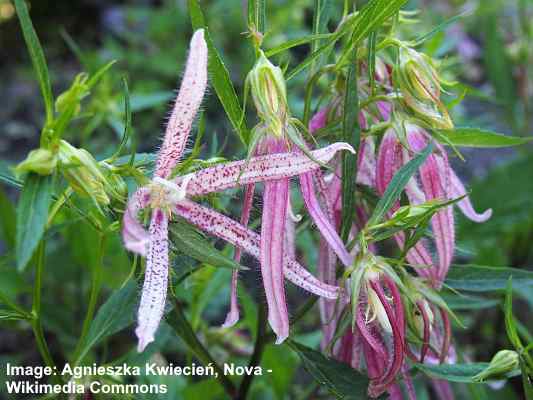
Campanula ‘Pink Octopus’
The ‘Pink Octopus’ campanula bellflower has long, spindly soft-pink flowers that flutter down from upright stems. These spreading perennial campanula flowers are described as “Japanese lantern buds” with light pink petals covered in small red dots. The nodding spider-like pink flowers grow abundantly on upright stems. This campanula flower grows 10” to 15” (25 – 37 cm) tall.
Campanula (Bellflower) ‘Birch Hybrid’

Campanula ‘Birch Hybrid’
The ‘Birch Hybrid’ bellflower has beautiful bell-shaped flowers that are a dramatic violet-blue color. The masses of purple flowers grow abundantly on trailing stems that are surrounded by rounded scalloped green leaves. The creeping campanula violet flowers look incredible in hanging baskets, trailing over a wall, or in rock gardens.
Campanula (Bellflower) ‘Sarastro’
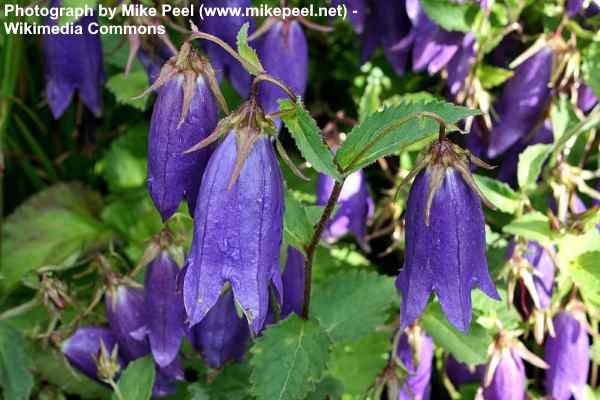
Campanula ‘Sarastro’
‘Sarastro’ campanula flowers are large, dark purple bell-shaped flowers with five-lobed petals. The bellflowers dangle on arching stems and contrast with the dark green, ovate leaves. This clump-forming perennial campanula plant blooms throughout the summer. The tall flowering bellflower ‘Sarastro’ grows up to 24” (60 cm) tall and wide.
Campanula lactiflora ‘Border Blues’ (Bellflower)
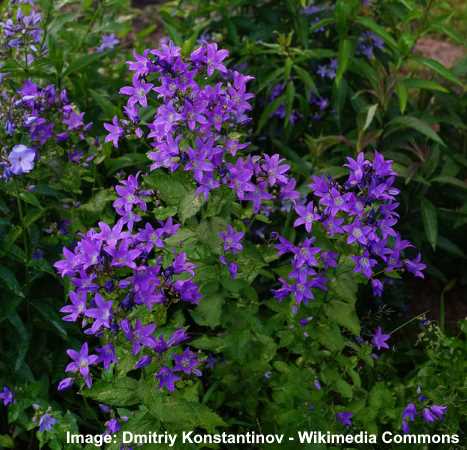
Campanula lactiflora ‘Border Blues’
The ‘Border Blues’ campanula flowers are eye-catching purple blooms with a distinctive star shape. The dark purple flowers have an open form and grow on all sides of the upright, erect stems. The purple flower color contrasts with the dark green lance-shaped serrated leaves. This variety is suitable for zones 5 through 7 and grows up to 5 ft. (1.5 m)
Campanula (Bellflower) ‘Blue Ocean’
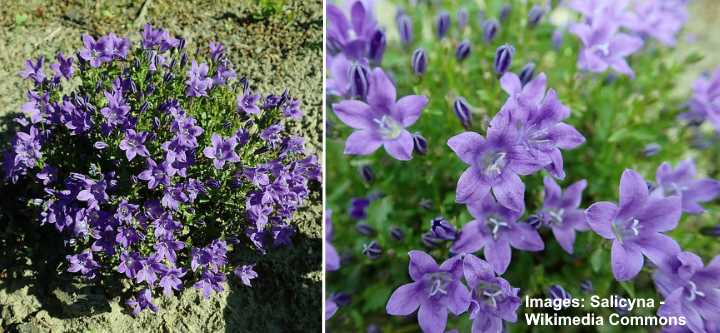
Campanula ‘Blue Ocean’
The ‘Blue Ocean’ campanula flowers are deep lilac star-shaped flowers with a bell-like form. The upright perennial plant with purple flowers facing upward grows in a compact, attractive rounded clump. Each delicate five-lobed light purple flower has a contrasting white throat and white stamens.
Campanula rapunculoides (Creeping Bellflower)
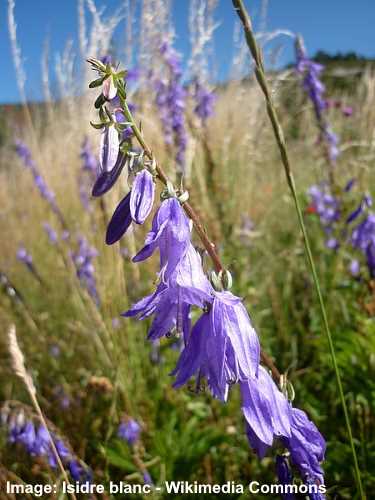
Campanula rapunculoides
The Campanula rapunculoides is also called the creeping bellflower. The flowering perennial is identified by its dangling purple bellflowers growing along one side of a stem. The nodding spikelike flowering stems produce numerous bell-shaped flowers measuring 0.8” to 1.6” (2 – 4 cm) long. This late-blooming bellflower plant blooms from mid-summer through September.
Campanula persicifolia (Peach-Leaved Bellflower)
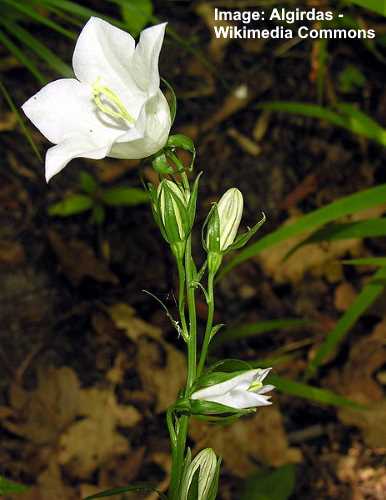
Campanula persicifolia
Also called the peach-leaved bellflower, the Campanula persicifolia has white cup-shaped delicate flowers growing along slender stems. The white fused petals have five pointed lobes and a wide, open shape. This herbaceous perennial bellflower plant grows up to 3 ft. (1 m) tall.
Campanula poscharskyana (Serbian Bellflower)
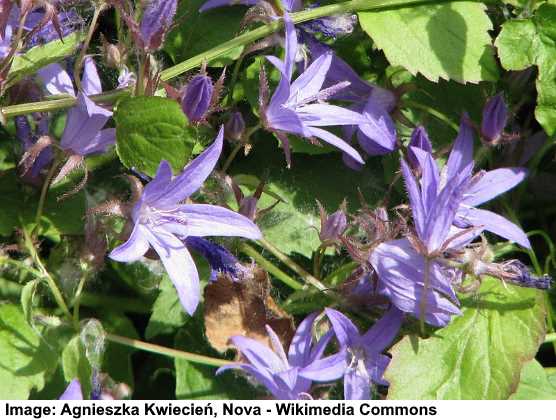
Campanula poscharskyana
The Serbian bellflower is a stunning trailing flowering plant with masses of light purple to lilac star-shaped flowers. The lavender-purple flowers look spectacular cascading over walls, trailing from hanging baskets or growing as ground cover. The creeping shoots can grow up to 10” (25 cm) long.
How to Grow Bellflower Plants
To grow campanula flowers, the plant should grow in well-draining, moderately fertile soil. The beautiful bell-shaped purple or blue flowers thrive in full sun to partial shade. Only water the plant during hot, dry weather and use an all-purpose, balanced fertilizer in spring to encourage blooming.
Under ideal conditions, campanula flowers will last from late spring until the first frost. You can also deadhead spent flowers to extend the blooming time.
It is straightforward to grow bellflower plants in your garden. In fact, in some areas, creeping campanula plants become invasive due to their prolific seeding habit and fast-growing, spreading roots. However, many gardeners enjoy the beauty that blue and purple campanula flowers bring to a summer landscape.
Where To Plant Bellflowers
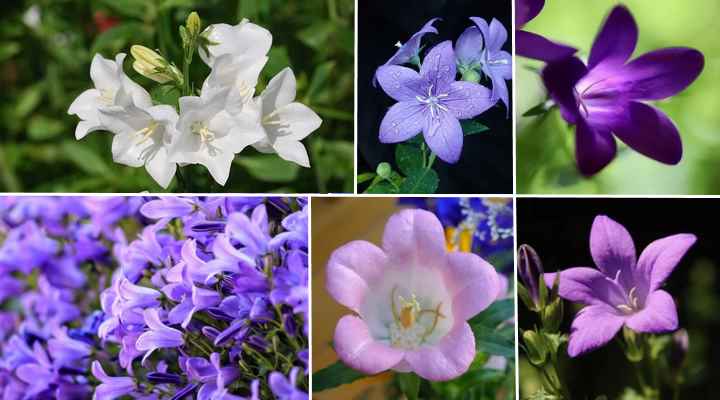
Plant campanula flowers in sunny area with well-drained loamy soil
Grow campanula flowers in a sunny location in your garden where there is sandy soil. The planting site must have loose, loamy soil that drains well. You can plant bellflowers in a rock garden, raised flower beds, hanging baskets, containers, or underplanting shrubs.
Where you plant campanula flowers depends on the species and type of plant. For example, upright bellflower plants are ideal for borders along driveways, back of bed flowers, or foundation plantings. On the other hand, trailing or creeping campanula flowers look better if the stems have room to hang—such as over a wall or from a hanging basket.
How to Plant Campanula Flowers in Pots
Campanula plants are perfect for growing in containers. With their trailing purple, blue, lilac, pink, and white star- or bell-shaped flowers, the long stems create eye-catching colorful floral displays. The pink, purple, and lilac colors contrast with lush green foliage that spills effortlessly over the sides of pots.
To grow campanula flowers in a pot, choose a container with drainage holes. Use a loose potting mix potting soil, and peat moss amended with perlite to improve drainage. The addition of peat moss helps to retain moisture, as the flowers need moist soil when in bloom.
How to Care for Potted Campanula (Bellflowers)
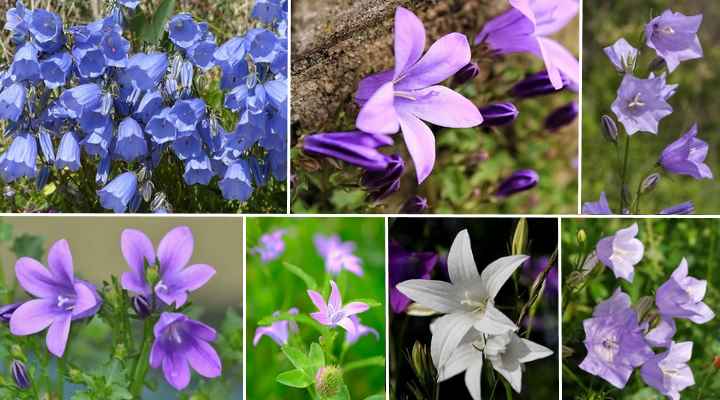
To care properly for indoors potted campanula plants, place them in indirect sunlight and only water when the top soil is dry
When growing bellflowers in pots, place the container in full sun or partial shade. For indoor potted campanula plants, avoid putting the plant in direct sunlight beside a south-facing window. Water the bellflower plants often enough to keep the soil moist without becoming soggy. Remove spent flowers to encourage blooming several times a year.
To bloom throughout the summer, campanula plants require moist but well-drained soil.
Here are some handy tips when growing potted campanula plants indoors:
- Always use room-temperature water, and water the soil, not the foliage or flowers
- Average room temperature and humidity are perfect for growing campanula flowers
- Only water the potting mix when the top 1” to 2” (2.5 – 5 cm) is dry to ensure adequate soil moisture
- Reduce watering in the fall and winter
- Deep watering is better than shallow watering
- Once established, campanula plants are relatively drought-tolerant indoor plants
Propagating Campanula Flowers
The two primary ways to propagate campanula flowers are by division and planting seeds. Many campanula varieties are biennial, and seed propagation is necessary to enjoy the blooms year after year. Other types of bellflowers are self-seeding and will grow as perennials in the garden.
How to propagate campanula plants using seeds: Collect the hard seed capsules (campanula fruit) after the blooms fade. Then, store them in a cool, dry place. In mid-winter, break open the seed heads, moisten the tiny seeds, and place them in a paper bag in the refrigerator for six to eight weeks.
The next step is to scatter the tiny seeds on a tray of moist, starting mix in late winter. Then place the tray in a warm, bright location that is between 68°F and 71°F (20°C – 21°C). The seeds should germinate in two to six weeks. Next, plant in the garden or a container when the seedlings are 4” (10 cm) tall.
Alternatively, you can just scatter the harvested seeds in the garden in the fall.
How to propagate campanula flowers through division: In spring, dig around the clump of bellflowers and gently remove the whole plant from the ground. Then, separate the plant’s roots into two or three sections. Next, plant the separated sections in a sunny spot in your garden and water thoroughly.
How to Care for Campanula (Bellflowers) in the Garden
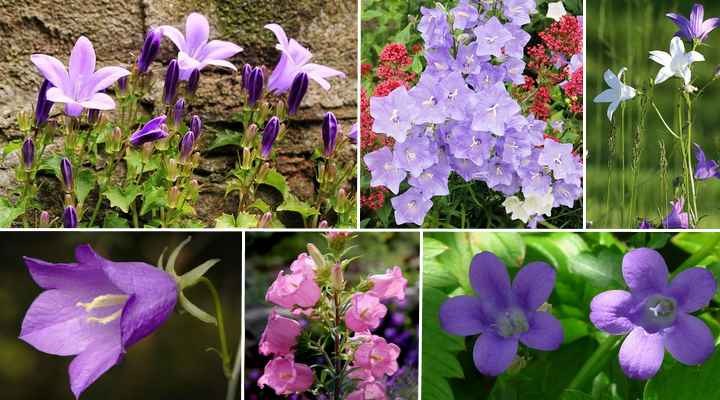
Growing campanula bellflowers outdoors is relatively easy in a sunny garden
Campanula flowers can care for themselves in the garden. However, with proper care and attention, you can help the beautiful purple and lilac flowers thrive without taking over your garden.
Where to Plant Flowering Campanula Plants
Plant campanula flowers in full sun or light shade and well-draining soil. Bellflowers will grow in shaded conditions; however, you may find that the plant doesn’t produce as many flowers. Additionally, full shade and humid conditions lead to issues with fungal diseases.
How to Water Campanula Flowers
Campanula flowers thrive when the soil is kept constantly moist. Therefore, water the campanula flowers when the top layer of soil dries. During hot, dry weather, you may have to water the ground once or twice a week. Letting the soil dry out entirely can cause flowers to wilt and can kill the plant.
Adding a layer of mulch around the root area can help to keep the soil moist. At the same time, you also help control weeds around the bellflowers. Use a 2” to 3” (5 – 7.5 cm) layer of mulch, keeping 2” free around the main stem.
Growing Campanula Bellflowers — Temperature and Humidity Requirements

Campanula bellflowers grow well in warm days and cool nights
Campanula flowers are hardy plants, with some varieties being winter hardy in USDA zone 3 and 4. Some types of cold-hardy campanula plants don’t perform well in overly hot or humid climates. In these areas, the plant’s foliage tends to suffer from powdery mildew.
In hot climates, it’s vital to protect the flowers from the hot midday sun. Generally, the campanulas prefer growing in climates with cool nights and warmer days.
Fertilizer for Growing Campanula Flowers
Campanula flowers benefit from fertilization twice a year—once in spring and once in mid-summer. Apply a balanced fertilizer with an NPK rating of 10-10-10. Alternatively, you can add a layer of organic compost or rotted manure to provide essential nutrients for flowering.
How to Prune Campanula
Campanula plants only require light pruning to encourage prolific blooming throughout the summer. You can also trim the length of trailing campanula stems to limit their growth and spread. Also, removing spreading stems can prevent the plant from invading other areas of your front or backyard.
Pinch off the tip of new shoots and the first few leaves to encourage more flowers to appear. If necessary, you can trim the plants back further. During the campanula blooming season from late spring until late fall, remove spent flowers from the stems.
Additionally, you can remove any stems that look scraggly, damaged, or out of place.
Pests and Diseases Affecting Campanula Flowers
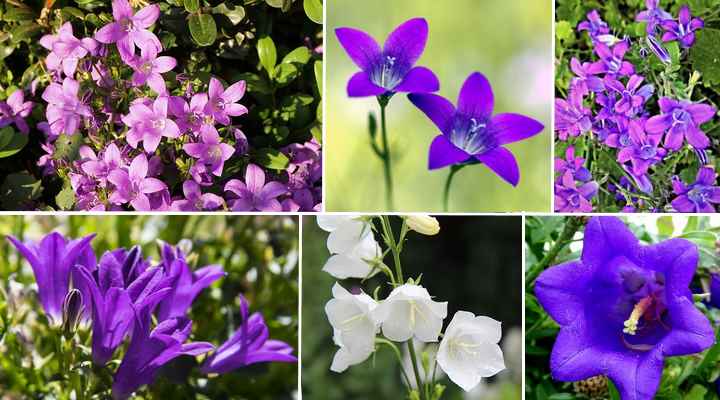
Proper care and growing conditions ensure healthy campanula bellflower plants
Pests that commonly affect bellflowers are aphids, thrips, spider mites, and whiteflies. Usually, a blast of the garden hose is enough to dislodge these unwanted plant pests. You can also use an insecticidal soap solution or neem spray to kill the bugs.
Related reading: How to kill aphids on outdoor plants.
Most of the diseases affecting campanula flowers are related to irrigation techniques—either too much water or too little water. Overwatering bellflowers results in soggy soil, which leads to root rot. This will cause plant foliage to develop rusty-colored or black spots. You should remove infected foliage and destroy (not compost) the leaves.
Powdery mildew can appear on the leaves as a fuzzy white coating. The best way to prevent this plant infection is to ensure the foliage has plenty of air circulation and avoid splashing water on the leaves.
Most campanula flowers are hardy plants resistant to bugs, pests, and diseases. However, the best way to prevent damage to plants is to ensure healthy growing conditions. Therefore, keep the soil moist, well-drained without being soggy, provide adequate sunlight, and ensure there’s enough air circulation between plants.
Why is My Campanula Plant Dying?
Overwatering is the main reason your campanula flowers are dying. Too much soil moisture causes leaves to develop soft spots or turn brown. If this is the case, hold off watering and increase light levels. However, if your plant doesn’t revive, you will need to dig it up and check for signs of root rot.
How to Get Rid of Creeping Bellflowers
In some cases, it’s necessary to remove campanula plants that have become invasive. For example, the best way to get rid of bellflowers is to dig up the plant around 8” (20 cm) deep and wide. Then, it’s necessary to remove all parts of the roots.
Another way to eradicate campanula flowers is to cover the clumps with newspaper and a thick layer of soil and mulch. This helps to kill off the plant by depriving it of sunlight.
Related articles:
- Ground Cover Plants with Purple Flowers
- Purple Perennial Flowers for Your Garden
- Beautiful Purple Flowering Vines
